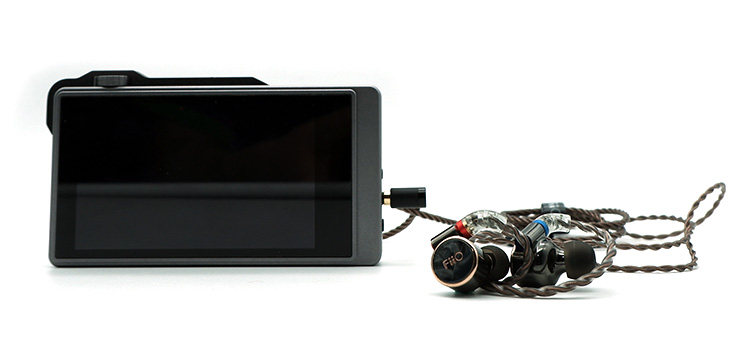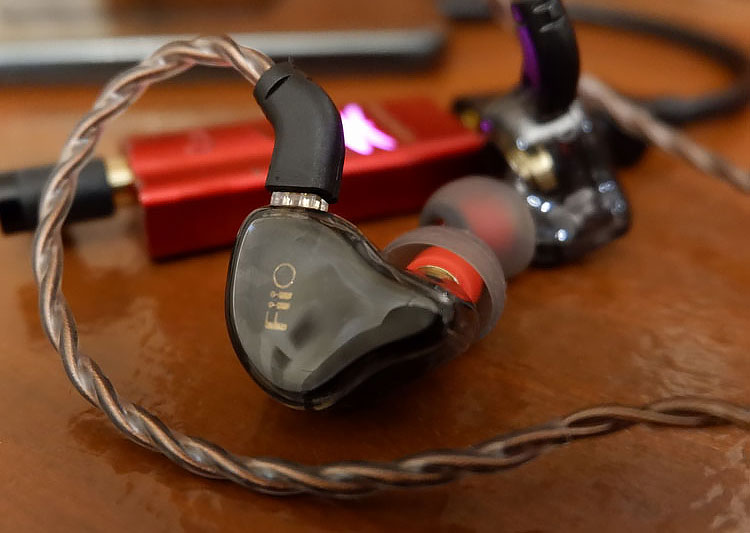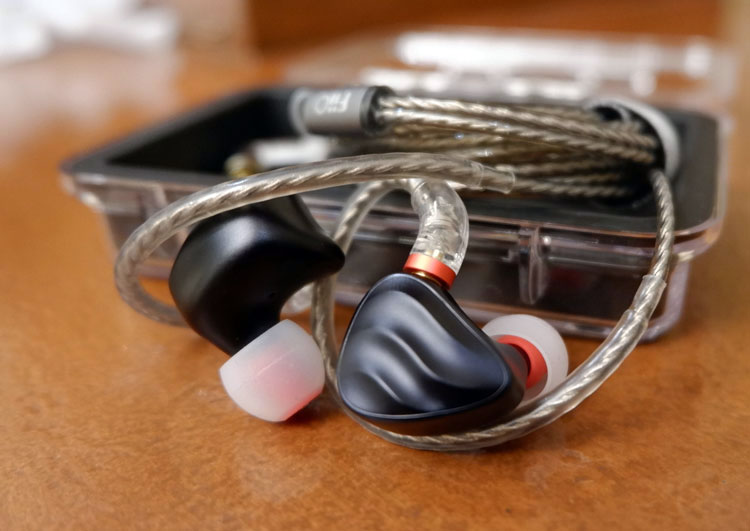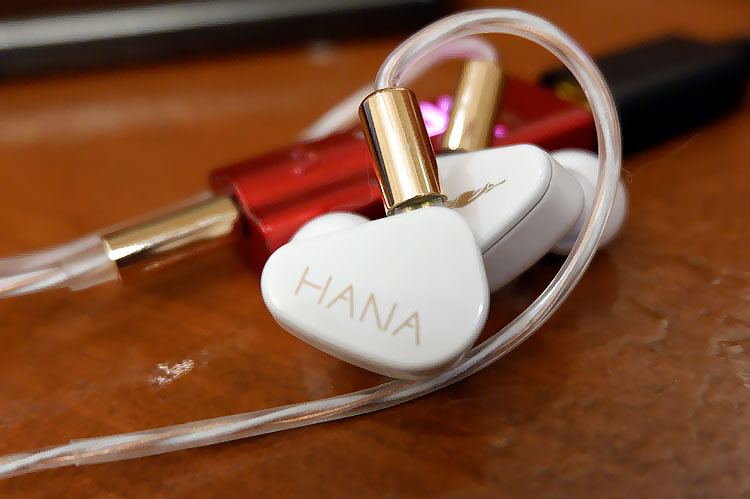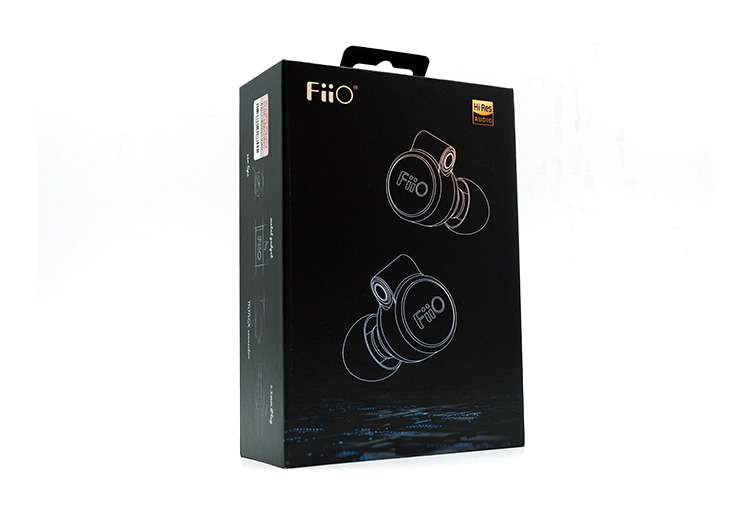Synergy
Efficiency
When pairing the FD3 with small dongle DACs like the Hidizs S3 Pro, the FD3 can be made to reach the proper volume level at just 60% of the maximum volume.
The Audioquest Dragonfly Red also produced a respectable volume for the FD3 at about 50% of the maximum volume. So, driving the FD3 off most portable sources will yield satisfyingly loud volumes.
Tuning
The FD3 comes complete with 2 options to fine-tune the FD3 to your preference. I personally ended up using the FD3 with the balanced, (stock), ear tips that were attached to the FD3 together with the black nozzles. This combination yielded the most balanced response for my taste.
There is another pair of nozzles with red bands, which are the ones that are attached to the FD3 by default. These filters tame down the treble while boosting up the bass for an overall warmer tonal balance.
Ear Tips
Another option for tuning the FD3 is the ear tips, which make a more significant difference than changing out the nozzles. The ear tips are labeled appropriately, where the vocal ear tips bring out the vocal range at the cost of less emphasis on the bass, while the bass ear tips make the bass more boosted while pushing back the vocal range.
Finally, the memory foam ear tips give the FD3 tighter imaging, while making things sound a lot more closed-in overall.
While the 3 other ear tip options are better for some genres of music, I ended up using the balanced ear tips for most of my listening sessions as they served as a middle ground for making most genres enjoyable.
Pairings
While the FD3 can easily be driven by most sources, the FD3 is sensitive enough to magnify the attributes of any upstream gear that is connected to it. When I listened using the S3 Pro, the soundstage is less layered, while leaving less control over a more forward bass region.
Moving on to the Dragonfly Red, there is an improvement in the layering of the soundstage, and an improved sense of control over the bass. However, the treble is not as refined as I expected it to be.
When I started using my main DAP, the ibasso DX200, there is a notable increase in layering within the soundstage. There is some decent depth and separation while maintaining control over the bass, and having an overall more textured presentation.
I then tried plugging the FD3 into my main desktop system, which is the Denafrips Ares II connected to a Burson Soloist 3X to see if the driver can scale.
While this is not a typical setup for IEMs, I can hear a notable improvement in the images formed within the soundstage. There is a better sense of dimensionality in the spatial cues while having an overall delineated imaging presentation. The treble body is also improved with more bite and edge.
Select Comparisons
FiiO FD1
$59.99
Technical
Being a notch down FiiO’s FD lineup, the FD1 has a similar driver complement to the FD3. However, the FD1 uses a smaller 10mm beryllium-coated dynamic driver. So the driver assembly on the FD1 is plainer with just a coating of Beryllium, and the absence of an acoustic prism for sound diffusion.
Both IEMs have the same 32Ω impedance, however, when it comes to sensitivity, the FD1 is 2dB less sensitive at 109dB/mW. While there is a difference in the sensitivity figures, and the FD1 ends up needing a smidge more power to produce the same volume.
Practically speaking though, both IEMs are easily driven off of anything that has a 3.5mm jack, so I wouldn’t concern myself too much about their sensitivity figures.
Design
Despite being part of the same series of IEMs in FiiO’s lineup, the 2 IEMs don’t look too similar. While their faceplates use a similar-looking celluloid inlay, the FD1 covers it with the smoked plastic shell instead of a clear 2.5D clear glass coating.
The shape of the shells on the FD1 is more of a faux-custom IEM type plastic shell, which makes it lighter but seemingly less durable overall.
Examining the cables on both IEMs, the cables that they come with seem to be identical. So microphonics won’t be much of a concern with either IEM. However, the FD1’s cable is terminated in a curved 0.78mm 2-pin connection instead of a more robust MMCX connection.
Performance
Coming from the same series, I was expecting that the 2 IEMs should sound similar, and maybe the FD1 would only be a more toned-down version? However, I was surprised that the 2 IEMs present a markedly different presentation.
There is a more pronounced mid-bass hump and bloom on the FD1 that compensates for the more rolled-off sub-bass region on the FD1. Also, the FD1 seems to stay a step behind the FD3 when it comes to the speed of the attack of bass notes, while both still manage a natural amount of decay.
When playing male vocals, the FD1 tends to have a more pronounced fundamental, which makes vocals sound more planted. Female vocals on the other hand sound more recessed and thinner with the FD1.
Midrange instruments take on a comparatively darker harmonic balance though. When it comes to vocal and instrument texture, the FD1 seems to be more smoothed over comparatively.
The FD1 stays on the safer side of the treble response, ensuring that it will not cause any fatigue. While treble details are still present, the sparkle in cymbals is not as brilliant as the FD1. There is also a notable reduction in the air frequencies with the FD1.
With the less extended treble region, the FD1 has a more congested and blurred soundscape presentation. While the FD1 can still easily present a soundscape with some width, it doesn’t quite go beyond my head, even with tracks that usually do.
FiiO FH3
$129.99
Technical
Internally, the FH3 seems to take the FD1’s single dynamic driver, and then adds 2 balanced armature drivers, one for the midrange and another for the treble frequencies. This driver complement adds up to a 24Ω impedance and a sensitivity of 114mW.
While the FH3 has more drivers, it ends up being more easily powered compared to the FD3’s single dynamic driver. I ended up having to turn down the volume by 1 notch when I play both IEMs through the Audioquest Dragonfly Red.
Design
Both IEMs use aluminum shells, however, they are visually different, with the FH3 having a larger shell to house more drivers inside the shell. The finish of the shells is also different, where the FH3 has a matte black finish, so it doesn’t have any film coating to protect it from scratches. But in my experience, the FH3 stands up to wear and tear well enough as it is.
While the cables on both IEMs are terminated in MMCX connections, the FH3’s stock cable is a more upscale silverplated copper cable. The coating of the cable is also thicker, where the FH3 has an extra clear PVC coating so individual strands of the cable can’t even be touched.
This extra PVC coating makes the cable a bit more rigid which makes them harder to entangle while ending up introducing some microphonics if you move around too much with the cables.
Performance
With a higher driver complement, I was expecting the FH3 to have a better performance overall. However, achieving better overall performance isn’t just about stuffing in more drivers.
When it comes to going deep into the sub-bass, the FH3 goes in deeper by a pinch while continuing to have an overall flatter bass response. However, when it comes to the texture of the bass region, the FH3 seems more glossed over, while having a less immediate sense of attack and decay.
While the FH3 readily conveys a better sense of vocal and instrument texture, the FH3 ends up being drier and less euphonic. The instrument timbre is brighter on the FH3 though, so it may seem like the FH3’s midrange presentation is more forward.
The lower treble on the FH3 is also more forward, having more substance behind each treble note. This allows the FH3 to have a detailed treble presentation while still staying safely away from being too shouty or become fatiguing. Upper treble frequencies on both IEMs are equally extended though.
The width of the soundstage is equally expansive on both IEMs, there doesn’t seem to be a hard wall to the sound of both IEMs. When it comes to forming images, the FH3 places them closer to the head while having less space between the cues. The FH3 goes deeper while having a better sense of scale for each image within the soundstage.
Tanchjim Hana
$159.99
Technical
When looking at the specs sheet, the impedance and the sensitivity ratings of the 2 IEMs are very similar at 32Ω, and a sensitivity of 110dB/mW, only 1dB less than the FD3.
With this in mind, I was expecting that both IEMs should play at equally loud volume levels, however, I ended up cranking up the volume a bit more when I was listening through the Hana. By my estimation, the Hana achieves the same volume level on the Dragonfly Red when I increase the volume by 1 notch.
Internally, the 2 IEMs make use of a dynamic driver. However, the Hana uses a high-rigidity Secondary Polymerized Liquid Crystal coupled to a high magnetic flux density DMT3 magnetic structure. These 2 technologies essentially claim something similar to the FD3’s 1.5Tesla magnetic flux density and Diamond-like Carbon diaphragm.
Design
Upon first inspection, both IEMs would seem like they’re solidly built with the Hana having a more fashionable white and rose gold aesthetic.
The shells of both IEMs are made of metal, however, the one on the Hana is made of SS316 stainless steel which makes it heavier and has the tendency to fall off the 2 pin connector from time to time.
The cables on the Hana also follow the white and rose gold aesthetic, while having a PVC sheath to cover the braids. It is still notably thinner than the FD3 cable despite the PVC outer covering.
Due to the form factor of the Hana being a more traditional teardrop-shaped IEM, it occupies a larger portion of my outer ear. This causes the IEM shells to touch my ears a bit more often, so it may cause more discomfort for longer listening sessions. Both IEMs are not particularly uncomfortable though.
Performance
Since the specifications on both IEMs claim that they have an extended frequency range, it’s no surprise that the Hana can easily reach down into the sub-bass region in a similar fashion.
However, when it comes to the midbass response, the Hana is more reserved, while maintaining more control over the bass region. This control makes the bass more rounded, but more glossed over.
The midrange on the other hand takes a step back comparatively. While the midrange lower treble transition allows the Hana to have a brighter harmonic tilt, the fundamental is lighter with the Hana offering more of a glossy percussion timbre.
The treble response on the Hana isn’t more elevated, rather the treble pitching instruments have a bit more weight to each note. This results in more bite and edge to go along with that shimmery tone.
Imaging and instrument placement is similarly accurate on both IEMs. However, when it comes to the overall width of the soundstage, Hana’s imaging presentation is more compressed both in terms of width and depth.
Our Verdict
The FD3 is consistent with FiiO’s current line of IEMs, and it makes a great impression by including a generous package of accessories, and thoughtful additions that give it a more premium experience than the price might suggest. While the FD3 has some obvious resemblance to the FD1, it’s simply a more upscale and more refined product overall.
Sonically, the FD3 is a welcome addition as the current middle child in FiiO’s FD IEM lineup. While the FD3 may not be the last word in treble bite and edge, the FD3’s semi-open back nature presents a wide soundstage width and a natural even-handed tonal balance.
FiiO FD3 Technical Specifications
- Material & Color: 6-series aluminium-magnesium alloy
- Driver Type: 12mm DLC diaphragm dynamic driver
- Frequency response: 10Hz~40kHz
- Sensitivity: 109dB@1mW
- Impedance: 32Ω@1kHz
- Connector Type: MMCX
- Cable: 4 strands of 120 wires Litz Type 2
- Weight (per unit): About 7.0g (excl. the cable)


